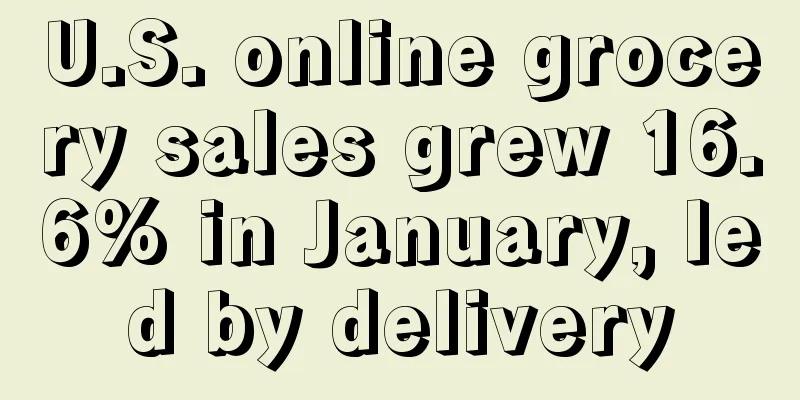U.S. online grocery sales grew 16.6% in January, led by delivery

|
It is learned that on February 11, according to foreign media reports, US online grocery sales continued to maintain strong growth in January, reaching 10 billion US dollars, a year-on-year increase of 16.6%. This growth momentum has continued for six months, mainly benefiting from the substantial discounts provided by membership and subscription plans. According to the latest report from Brick Meets Click/Mercatus, all three major delivery methods achieved year-on-year growth. Among them, the delivery method performed the best, with a sharp increase of 37% to US$4.1 billion. Since mid-2024, the delivery model has continued to benefit from membership and subscription discounts, which has led to a significant increase in monthly active users, a significant increase in order frequency, and a slight increase in average order value. This growth trend has increased the market share of the delivery method by 610 basis points compared with the same period last year, and as of the end of January, its share of online grocery sales reached 41%. Self-pickup sales also increased, but the increase was relatively small, up 4% year-on-year to $4.2 billion. Although the average order value has increased, the number of monthly active users and order frequency have both declined. Analysis pointed out that the slowdown in the self-pickup business was mainly affected by promotional activities, as consumers tend to choose discounted delivery services. As of the end of January, the market share of self-pickup fell by 500 basis points to 42%, but it was still slightly higher than the delivery model. Meanwhile, home delivery sales increased 9% year-over-year to $1.6 billion. Despite a decline in average order value, growth in monthly active users and increased order frequency drove overall sales. However, home delivery's relatively low growth compared to delivery and pickup led to a 110 basis point year-over-year decline in its market share to 16% at the end of January. David Bishop, partner at Brick Meets Click, pointed out that the rapid growth of the delivery model is mainly driven by large retailers such as Walmart. The continuous promotion strategy not only effectively increases consumers' purchase frequency and spending, but also improves user retention and market share, which is expected to intensify industry competition and make other retailers face greater challenges in the future. Despite the significant growth in online grocery sales, total spending in the overall U.S. grocery market only increased by 2.5% year-on-year. Against this backdrop, the market share of online sales increased to 15%, up 180 basis points from the same period last year. This trend shows that consumers are accelerating their shift to online channels, and membership discounts and convenience remain key factors driving the growth of online groceries. Author ✎Rayna/ Statement: This article is copyrighted and may not be reproduced without permission. If you need authorization, please contact: happy |
Recommend
Amazon's own business was cut!? European site is about to take off
More than a month has passed since the sellers be...
What is Sistrix? Sistrix Review
Sistrix is well known in German-speaking countri...
Specific steps to solve Amazon's misjudgment of restricted products
Whether you are a novice seller or an old seller,...
What is Wynn Octopus? Wynn Octopus Review
Shenzhen Yongli Octopus Logistics Co., Ltd. is com...
Hangzhou's big sellers implement a 4.5-day work week! The first "anti-involution horn" in the cross-border circle is sounded
The 4.5-day work week is coming to the cross-bord...
The US e-commerce market has exceeded one trillion US dollars for the first time! The five major categories have the highest revenue
It is learned that according to Comscore data, the...
Big event! Employees of Amazon, Walmart, Target and other companies launched a joint strike
01 Another Amazon warehouse worker dies from coron...
Walmart continues to expand its B2B e-commerce business and launches a shopping app
Walmart recently announced the launch of the Walma...
What is Amazon Transparency? Amazon Transparency Review
Amazon Transparency, also known as the "Amazo...
Big news! Savitech will be officially launched on July 12!
It is learned that on July 11, Suntech Power issue...
For Amazon sellers: 11 useful user review management and review request tools
Amazon uses seller metrics to measure whether sel...
Monthly income of 2 million? Freight forwarders earn much less than you think...
When it comes to freight forwarders, sellers proba...
TikTok's new policy is released! This type of cross-border seller has an opportunity
TikTok's successful overseas expansion has no...
Google officially opens Bard public beta, starting with the UK and the US
It is learned that on March 21, Google announced t...
Prime Day sales boom but still a loss of 30,000! Sellers set up stalls on the street to clear out inventory?
It is learned that during this year's Prime Da...









